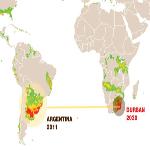There have been many warnings that climate change could make it more difficult to grow food. But a new tool may allow farmers to glimpse the future and prepare for what lies ahead.
Scientists say climate change may significantly alter growing conditions for most farmers. But that doesn't mean those conditions will be unknown or unexpected. They say there are plenty of examples of how farmers have already adapted to higher temperatures.
Researchers at the CGIAR Research Program on Climate Change have released a report called: Climate Analogues – Finding Tomorrow's Agriculture Today.
"Climate analogues are a way of finding the future today. We talk about how climate will change and it's quite an abstract idea to say, well, this place will be two degrees warmer. But these climate analogues are an interesting way of actually seeing what that really feels like. So, you can find the future of a site when temperature is higher, for example, or precipitation is different, and you can find that today somewhere else," said Dr. Andy Jarvis of CGIAR.
It will be here like it is there
For example, researchers studied temperature changes projected to occur by 2030 for Shanghai, China, and Los Angeles, California and Durban, South Africa, site of the latest U.N. climate change conference.
"If you look for Durban's 2030 climate, you can actually find quite a large area that has very similar climates to what we project for 2030 for Durban in Argentina and Uruguay," said Jarvis.
That information could be very valuable to farmers.
"Durban, for example, has a lot of very high productivity sugar cane around it. There are also a lot of farmers who depend on maize for subsistence. And so you can go to Argentina and Uruguay where they have established sugar cane and established maize crops and understand really what is it that they're doing that makes them well adapted to their climate. And so that knowledge can then feed into farmers in Durban and help them adapt," he said.
The climate analogues say that the soybean growing area near Shanghai will correspond to major soybean areas in the eastern United States, Argentina and South Africa.
The information can be used to help ensure food security, especially with the population expected to soar in the coming decades.
"You have climate change affecting our ability to produce food, but at the same time population [is] on the increase. We just went past 7 billion. Projections for 9 billion in 2050. It's not just population increase, but it's changing consumer patterns, as well. So, the consumption of milk and meat, for example, is on the increase in countries like China. So that's putting tremendous demands on the food system," he said.
Farmers need to adapt
Jarvis said there are no magic solutions to climate change, so governments need to reach a legally binding agreement on greenhouse gas emissions. However, Jarvis says that's not enough. Farmers need to adapt, especially smallholder farmers.
"Smallholder poor farmers in Africa are those that are most vulnerable. They have [the] least capacity to adapt. Ironically, they're the ones that are least really responsible for climate change, but the ones that are going to be most affected," he said.
Jarvis added that farmers are on the frontlines of climate change, adding he never met one who doubted climate change was taking place.
